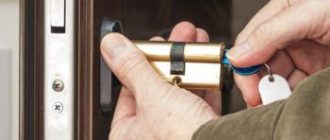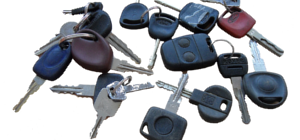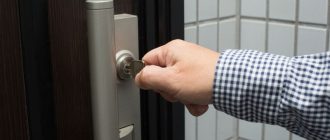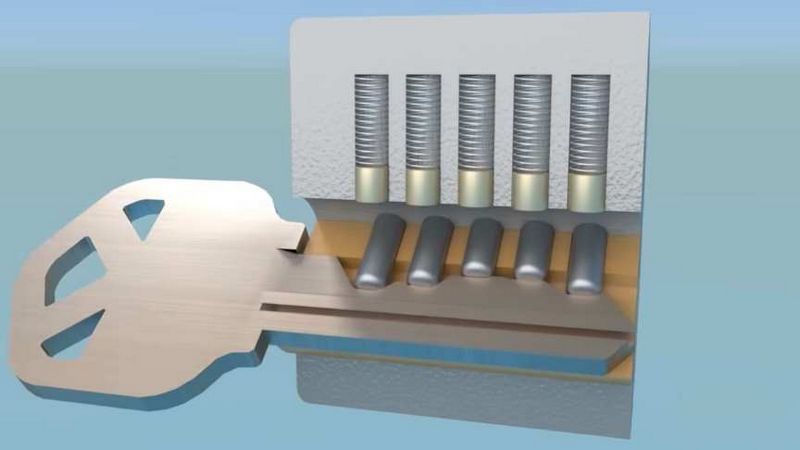
How Do Electronic Door Locks Work
Electronic door locks have become increasingly popular in recent years. These high-tech locks offer a range of benefits over traditional lock and key systems. But how do they actually work?
At their core, electronic door locks function by using an electrical current to control the locking mechanism. Instead of using a physical key, these locks rely on electronic signals to unlock and lock the door.
One common type of electronic door lock is the keypad lock. This type of lock features a keypad where a user can enter a unique code to unlock the door. The lock then processes the code and uses an electrical current to release the locking mechanism, allowing the door to be opened.
Another popular type of electronic door lock is the proximity lock. These locks use radio frequency identification (RFID) technology to unlock the door. A small device, such as a key fob, card, or even a smartphone, contains a chip that emits a signal. When the device comes into close proximity to the lock, the lock receives the signal and unlocks the door.
Overall, electronic door locks offer convenience, security, and flexibility. They eliminate the need for physical keys, which can be lost or stolen, and allow for easier access control. Understanding how these locks work can help you make an informed decision when it comes to choosing the right lock for your needs.
What are electronic door locks?
Electronic door locks are a type of lock that uses electronic components to control access to a door. Unlike traditional mechanical locks, which require a physical key to open and close, electronic door locks use electronic signals to operate.
These locks typically consist of a lock mechanism, an electronic control unit, and a power source. The lock mechanism is responsible for physically securing the door, while the electronic control unit interprets and processes electronic signals to control the lock. The power source provides the necessary electrical energy to power the electronic components.
Electronic door locks work by receiving an input signal, typically in the form of a key card, keypad code, or smartphone app. Once the input signal is received, the electronic control unit verifies the authenticity of the signal and initiates the unlocking or locking process. This can involve activating a motorized mechanism to move the lock’s bolts or disengaging a latch to release the door.
The electronic control unit may also include additional features, such as the ability to store multiple access codes, log access activity, and integrate with other security systems. These features make electronic door locks a versatile and customizable option for securing doors in various settings, including residential homes, commercial buildings, and even hotels.
Overall, electronic door locks offer an alternative to traditional locks that provides enhanced security and convenience. By eliminating the need for physical keys, they eliminate the risk of lost or stolen keys and allow for easy access control management. With their advanced technology, electronic door locks are becoming increasingly popular and are quickly replacing mechanical locks in many applications.
Advantages of electronic door locks
Electronic door locks have become increasingly popular due to their convenience, security, and ease of use. Here are some of the advantages of using electronic door locks:
|
Convenience: Electronic door locks offer a high level of convenience as they eliminate the need for carrying keys. With an electronic door lock, you can easily enter your home by simply entering a code, using a keycard, or even using your smartphone. |
|
Security: Electronic door locks provide a higher level of security compared to traditional locks. They are designed with advanced encryption technology, making it difficult for intruders to pick or manipulate the lock. Additionally, electronic door locks often have built-in alarm systems that can alert you of any unauthorized access attempts. |
|
Ease of use: Electronic door locks are incredibly easy to use. Most models come with simple, user-friendly interfaces that allow you to easily setup and customize your access codes. Some electronic door locks even have features like remote access control, allowing you to lock and unlock your door from anywhere using your smartphone or tablet. |
In conclusion, electronic door locks offer a range of advantages, from convenience and security to ease of use. If you are looking for a modern and efficient way to secure your home or office, electronic door locks are definitely worth considering.
Types of electronic door locks
Electronic door locks come in a variety of types, each offering unique features and levels of security. Here are some common types:
| Keypad locks | Keypad locks require the user to enter a preset code to unlock the door. These codes can be easily changed, making it convenient to grant access to different individuals. |
| Key fob locks | Key fob locks work by using a small electronic device, usually carried on a keychain, to wirelessly communicate with the lock. When the key fob is within range, the lock can be easily unlocked. |
| Biometric locks | Biometric locks use unique physical characteristics, such as fingerprints or iris scans, to grant access. These locks offer a high level of security, as the individual’s biometric data is difficult to replicate. |
| Smart locks | Smart locks connect to a smartphone or other mobile device via Bluetooth or Wi-Fi. They can be controlled remotely, allowing for convenient access management. Some smart locks can even integrate with home automation systems. |
These are just a few examples of the types of electronic door locks available. The choice of lock will depend on the specific needs and preferences of the user.
Keypad electronic door locks
Keypad electronic door locks are a popular choice for securing homes and businesses. These locks use a numeric keypad instead of a traditional key or keycard to grant access to a building.
So, how do keypad electronic door locks work? When a person wants to enter a building, they simply enter a preset code into the keypad. The lock then compares the entered code to the stored code in its memory. If the codes match, the lock will unlock the door, allowing the person to enter. If the codes do not match, the lock will remain locked.
Most keypad electronic door locks allow for multiple user codes to be programmed, which is convenient for families or organizations with multiple keyholders. These locks also typically have a backup key option in case the code is forgotten or the keypad malfunctions.
Additionally, keypad electronic door locks often have additional security features, such as a temporary lockout after a certain number of incorrect code entries or an alarm that sounds if someone tries to tamper with the lock.
Keypad electronic door locks provide several advantages over traditional locks. They eliminate the need for physical keys, which can be lost or stolen. With a keypad lock, there is no risk of someone making unauthorized copies of a key. Keypad locks also offer convenience, as there is no need to carry around a key or remember where it is.
In conclusion, keypad electronic door locks are an effective and secure way to control access to a building. They use a numeric keypad to grant entry and offer additional security features. These locks provide convenience and eliminate the need for physical keys. If you’re looking for a modern and reliable door lock, a keypad electronic lock could be the right choice for you.
Keycard electronic door locks
Keycard electronic door locks are a type of electronic lock that use a keycard instead of a traditional key. These locks offer enhanced security and convenience for users.
- Keycard electronic door locks work by utilizing a card with a magnetic stripe or a RFID (Radio Frequency Identification) chip.
- When the card is inserted or waved in front of the lock’s reader, it sends a signal to the lock to release the mechanism and allow access.
- These locks can be programmed to recognize multiple keycards, allowing authorized individuals to easily gain entry.
- Keycards can be easily programmed and reprogrammed, making it simple to add or remove access for specific individuals.
- These locks often have features such as time restrictions or audit trails, which can provide additional security and tracking capabilities.
Overall, keycard electronic door locks provide a convenient and secure way to control access to buildings, rooms, or other areas, ensuring only authorized individuals can enter.
Biometric electronic door locks
In the world of electronic door locks, biometric technology is revolutionizing the way we secure our homes and businesses. A biometric electronic door lock uses unique physical characteristics, such as fingerprints or facial recognition, to grant access to authorized individuals.
So, how do biometric electronic door locks work? When a person approaches the door, the lock’s sensor scans their biometric data, such as their fingerprint or facial features, and compares it to the stored data in its database. If the biometric data matches, the lock will release and grant access to the person. If not, the door will remain locked.
One of the key advantages of biometric electronic door locks is their high level of security. Unlike traditional lock and key systems, biometric locks rely on unique biological characteristics that are difficult to forge. This makes it almost impossible for unauthorized individuals to gain access to a secured area. Additionally, the speed and convenience of biometric locks make them an attractive option for high-traffic areas where frequent access is required.
Biometric electronic door locks come in various forms, such as fingerprint scanners and facial recognition systems. Fingerprint scanners work by capturing the unique patterns and ridges on a person’s fingertip. Facial recognition systems, on the other hand, analyze the unique features of a person’s face, such as the distance between the eyes or the shape of the jawline.
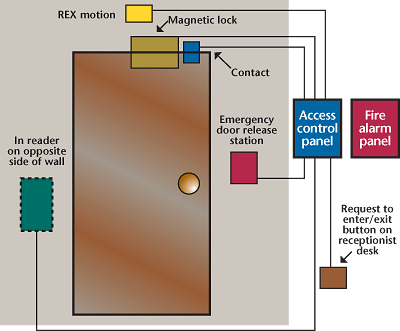
Overall, biometric electronic door locks offer an advanced level of security and convenience. By utilizing the unique physical characteristics of individuals, they provide a reliable and efficient way to control access to doors, ensuring that only authorized individuals can enter.
Smartphone-controlled electronic door locks
In the ever-evolving world of technology, electronic locks have become increasingly popular. With the convenience and security they offer, it’s no wonder that many people are choosing to switch from traditional lock systems to electronic ones. One of the latest innovations in this field is smartphone-controlled electronic door locks.
So, how do these locks work? Well, first of all, they utilize the power of your smartphone. By connecting your phone to the lock system via Bluetooth or Wi-Fi, you can control the lock remotely. This means that you can lock or unlock your door from anywhere, as long as you have an internet connection.
But it doesn’t stop there. Smartphone-controlled electronic door locks also offer additional features such as keyless entry. Instead of using a physical key, you can simply use your smartphone to unlock the door. This eliminates the need to carry around keys and reduces the risk of losing them.
Additionally, these locks often come with a companion app that allows you to customize your lock settings. For example, you can set specific access times for different users, create temporary access codes for guests, or receive notifications whenever the door is locked or unlocked.
Another advantage of smartphone-controlled electronic door locks is the ability to integrate them with other smart home devices. This means that you can create customized automation scenarios, such as automatically locking the door when you leave home or unlocking it when you approach.
In conclusion, smartphone-controlled electronic door locks provide a convenient and secure way to control access to your home. With their ability to be controlled remotely via smartphone, keyless entry, and integration with other smart home devices, they offer a range of benefits that traditional locks simply can’t match.
How do electronic door locks work?
Electronic door locks are a modern and convenient alternative to traditional locks. They work by using electronic components and mechanisms to secure and unlock a door without the need for a physical key.
These locks typically consist of a keypad or touch screen, a lock mechanism, and a control panel. The keypad or touch screen is used to enter a PIN code or a password to gain access to the door. Once the correct code is entered, the lock mechanism is activated and the door is unlocked.
The lock mechanism itself is made up of several parts. It usually includes an electric motor or solenoid that controls the locking mechanism, a latch or deadbolt that secures the door, and sensors that detect when the door is open or closed.
When a user enters the correct code on the keypad or touch screen, a signal is sent to the control panel, which then activates the electric motor or solenoid. The motor or solenoid moves the latch or deadbolt into the unlocked position, allowing the door to open.
Electronic door locks can also be programmed to allow access to specific individuals at certain times. This is particularly useful in commercial settings where different employees may have different access privileges. The control panel can be programmed to grant or deny access based on the codes entered and the time of day.
Overall, electronic door locks provide enhanced security and convenience. They eliminate the need for physical keys, which can be lost or stolen, and offer additional features such as remote access and integration with smart home systems.
Components of electronic door locks
Electronic door locks are a modern and secure way to protect your home or office. These locks work by using electronic components to control access to a door, replacing the traditional key and lock mechanism.
There are several key components that make up an electronic door lock system:
1. Keypad or Touchscreen: The keypad or touchscreen is the interface that allows users to input a code or password to unlock the door. This component is usually located on the outside of the door and can be a physical keypad or a digital touchscreen.
2. Control Unit: The control unit is the brain of the electronic door lock system. It receives the input from the keypad or touchscreen and processes it to determine whether to unlock the door or not. This component is usually located inside the door and is connected to the keypad or touchscreen.
3. Lock Mechanism: The lock mechanism is responsible for physically locking or unlocking the door. It is controlled by the control unit and can be either an electric strike plate or an electromechanical lock. The lock mechanism is usually located on the inside of the door.
4. Power Supply: The power supply provides the necessary electricity to operate the electronic components of the door lock system. It can be a battery or a wired power source. The power supply is usually located inside the door and is connected to the control unit.
5. Sensors: Some electronic door locks come with sensors that detect when someone is approaching the door. These sensors can be motion sensors or proximity sensors, and they trigger the control unit to activate the lock mechanism.
6. Backup Battery: Many electronic door locks have a backup battery that allows the lock to function even in case of a power outage. This ensures that you will still be able to unlock the door even if there is no electricity.
7. Remote Access: Some electronic door locks can be controlled remotely using a smartphone or computer. These locks are connected to the internet and allow users to lock or unlock the door from anywhere in the world.
By understanding the components of electronic door locks, you can make an informed decision about which lock will best suit your needs and provide the security and convenience you desire. These locks offer a modern and advanced alternative to traditional locks and can greatly enhance the security of your home or office.
Benefits of electronic door locks
Electronic door locks offer a variety of advantages and increased security compared to traditional lock systems. Here are some of the key benefits:
| Convenience | Electronic door locks provide convenience and ease of use. They eliminate the need for physical keys, which can be lost or forgotten. Instead, users can simply enter a code, use a keycard, or utilize biometric authentication to gain access. |
| Enhanced security | Electronic door locks offer improved security features compared to traditional locks. They often include built-in alarms, tamper-proof mechanisms, and encryption technology. This makes it much more difficult for unauthorized individuals to gain access to a property. |
| Remote access | One of the greatest benefits of electronic door locks is the ability to remotely control access to your property. With a smartphone or computer, you can lock or unlock your doors from anywhere. This is particularly useful for granting access to guests, service providers, or when you forget to lock the door. |
| Activity monitoring | Some electronic door locks have built-in activity monitoring capabilities. This allows you to track who has entered or exited your property and at what time. This feature can be helpful for security purposes or for keeping track of the comings and goings of household members. |
| Integration with smart home systems | Electronic door locks can be integrated into smart home systems, allowing for seamless automation and control. They can be synchronized with other devices such as security cameras, lights, and voice assistants. This integration enhances the overall security and convenience of your home. |
Overall, electronic door locks provide a range of benefits that make them a popular choice for both residential and commercial settings. They offer convenience, enhanced security, remote access, activity monitoring, and integration with smart home systems, making them an excellent investment for modern homes and businesses.
Installation of electronic door locks
Electronic door locks are becoming increasingly popular due to their convenience and security features. Installing these locks is a straightforward process that can be done by either a professional locksmith or a knowledgeable homeowner.
The first step in the installation process is to choose the appropriate electronic door lock for your needs. There are a variety of options available, including keypad locks, key fob locks, and biometric locks. Consider factors like durability, ease of use, and compatibility with your existing door hardware when making your selection.
Once you have selected a lock, the next step is to remove your existing door lock. This typically involves removing the screws or bolts that secure the lock to the door, and then disconnecting any electrical connections if necessary. Make sure to keep any hardware or accessories that may be needed for the installation of the new lock.
After removing the old lock, follow the manufacturer’s instructions to install the new electronic door lock. This will typically involve attaching the lock to the door using screws or bolts, and then connecting any electrical components if applicable. It is important to ensure that the lock is aligned correctly and securely attached to the door.
Once the lock is installed, test it to ensure that it is functioning correctly. This may involve entering a code or using a key fob to lock and unlock the door. Make any necessary adjustments to the lock or door hardware to ensure smooth operation.
Electronic door locks offer many advantages over traditional locks, including remote access, temporary access codes, and activity logs. However, it is important to follow the manufacturer’s instructions and take note of any specific installation requirements to ensure optimal performance and security.
In conclusion, the installation of electronic door locks is a relatively simple process that can be done with basic tools and a little bit of know-how. By following the manufacturer’s instructions and taking the time to properly install the lock, you can enjoy the convenience and security provided by these state-of-the-art door locks.
Common issues with electronic door locks
Electronic door locks are designed to provide convenience and security for homes and businesses. However, like any technology, they can sometimes encounter issues that may affect their functionality. Here are some common issues that can arise with electronic door locks:
- Power supply: One of the most common problems with electronic door locks is related to the power supply. If the battery is low or dead, the lock may not work properly. It is important to regularly check and replace the batteries to ensure smooth operation.
- Connectivity: Electronic door locks often rely on wireless or Bluetooth connectivity to communicate with smartphones or other devices. If there are connectivity issues, the lock may not respond to commands or may have a delayed response. It is advisable to check the connection and ensure that it is stable.
- Programming: Programming errors can also cause issues with electronic door locks. If the lock is not properly programmed, it may not recognize authorized users or may not lock or unlock as intended. Double-checking the programming settings and following the manufacturer’s instructions can help resolve this issue.
- Mechanical problems: Mechanical issues like jamming or misalignment can also affect the functionality of electronic door locks. If the lock is not aligned properly or if there is debris or obstruction in the mechanism, it may cause the lock to malfunction. Regular maintenance and cleaning can help prevent these issues.
- Environmental factors: Extreme weather conditions, such as excessive heat or cold, can impact the performance of electronic door locks. The electronic components may be sensitive to temperature changes, which can affect their operation. It is important to choose a lock that is designed to withstand the specific environmental conditions of the installation location.
- Security vulnerabilities: While electronic door locks are generally secure, they may still have vulnerabilities that can be exploited by hackers. It is important to regularly update the lock’s firmware and use strong passwords to minimize the risk of unauthorized access.
Understanding these common issues can help users troubleshoot problems with their electronic door locks and ensure their long-term reliability and security.
Maintenance of electronic door locks
Electronic door locks provide an efficient and convenient way to secure your home or office. However, like any other mechanical or electronic device, they require regular maintenance to ensure their proper functioning. Here are some essential maintenance tips to keep your electronic door locks in optimal condition:
- Keep the lock clean and free from dust and debris. Regularly wipe down the exterior surfaces with a soft, damp cloth to prevent build-up.
- Use a lubricant specifically designed for electronic locks to keep the moving parts operating smoothly. Apply the lubricant according to the manufacturer’s instructions.
- Check the batteries regularly and replace them as needed. Weak batteries can cause the lock to malfunction or fail to operate.
- Inspect the electronic components for any signs of damage or wear. If you notice any issues, contact a professional locksmith or the manufacturer for repairs or replacements.
- Test the lock periodically to ensure that it is functioning correctly. Follow the test procedure provided by the manufacturer.
- Keep the access codes or keys secure and update them regularly. Change the codes or keys if you suspect any unauthorized access.
- Ensure that the door and frame are properly aligned to prevent unnecessary stress on the lock.
- If the lock has a remote functionality, ensure that the remote control is properly synced and functioning as expected.
- Keep an eye out for any software updates or firmware upgrades provided by the manufacturer. These updates may include security enhancements or bug fixes.
By following these maintenance tips, you can prolong the lifespan of your electronic door lock and ensure its reliable operation. Regular maintenance will also help prevent any potential security vulnerabilities.
Q&A:
What are electronic door locks and how do they work?
Electronic door locks are security devices that use electronic components rather than traditional keys to control access to a building or room. These locks typically consist of a keypad, card reader, or bio-metric sensor, and a locking mechanism. When a person needs to gain access, they input a code, swipe a card, or provide a fingerprint, which is then verified by the electronic system. If the verification is successful, the locking mechanism is released, allowing the person to enter.
What are the advantages of using electronic door locks?
There are several advantages to using electronic door locks. Firstly, they provide an added level of security as they are difficult to pick or tamper with compared to traditional locks. Secondly, they eliminate the need for physical keys, reducing the risk of lost or stolen keys. Additionally, electronic door locks can be easily programmed to allow temporary access for visitors or contractors, and the access codes can be changed regularly to enhance security.
Can electronic door locks be hacked?
While no security system is entirely foolproof, electronic door locks have advanced security measures in place to protect against hacking. These locks often use advanced encryption algorithms to prevent unauthorized access and have built-in safeguards against hacking attempts. However, it’s important to choose a high-quality, reputable electronic door lock from a trusted manufacturer to minimize the risk of hacking.
Can electronic door locks be installed on any type of door?
Electronic door locks can be installed on most types of doors, including wood, metal, and glass doors. However, the installation process may vary depending on the type of door and the specific electronic lock being used. It’s important to consult the manufacturer’s guidelines and, if necessary, hire a professional locksmith or installer to ensure the electronic door lock is properly installed and functions correctly.

